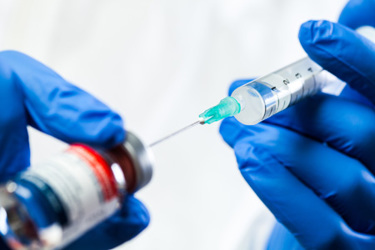CBER's Peter Marks On Complex Biologics Manufacturing Advances

By Matthew Pillar, Editor, Bioprocess Online

While the ISPE opted to run its 2022 Biotechnology Conference in hybrid fashion June 28-30, the virtual option didn’t stop a few hundred live attendees from converging on Copley Place to take in the sessions and exhibition in the flesh. I was among them, and it was good to find myself back in an immersive conference experience and in the company of biopharma’s brightest.
Peter Marks, MD, PhD and Director at FDA’s Center for Biologics Evaluation and Research (CBER) keynoted the general session on Tuesday, offering insight into the agency’s perspective on advanced manufacturing principles in the context of increasingly advanced biologics. From the outset, Dr. Marks sought to disarm the audience of any notion that the Agency might be a gatekeeper to innovation. Sharing a multiple-choice question with the audience, he asked:

- Preclinical candidate development & testing
- Conducting randomized control-type clinical trials
- Process development and manufacturing scaleup
- Regulatory pathways and regulatory review
As you might have guessed, choice D brought the lowest response. The real bottleneck, according to Dr. Marks, was process development and manufacturing scale-up.
Following with a brief review of the traditional vaccine development and manufacturing chronology—a process that’s typically de-risked early on in development given that manufacturing must accommodate massive commercial production at a low cost—Dr. Marks remarked that manufacturing scale up challenges aren’t typically addressed until very late in the process, often after large Phase 3 trials have proven the product’s effectiveness. “Those scale up challenges often result in delays in terms of availability of prophylactic vaccines against infectious disease, which doesn’t sound like a big problem as long as there’s an adequate supply of an alternative,” he said. “When you’re in a pandemic, unnecessary delays can be a problem.”
That problem, he says, was addressed head-on during Operation Warp Speed, when manufacturing development took place concurrent with condensed Phase 1, 2, and 3 trials. Risky, yes. But as soon as data indicated that the vaccines might have the potential to provide immune response, manufacturing scale-up commenced, and by the time large, randomized Phase 3 trials concluded, millions of doses of the COVID-19 vaccine were available. “They would have all been thrown out if not found to be safe and effective, but it would have been a small price to pay to be prepared for the alternative of having something ready.”
That’s when Dr. Marks turned his attention to the bottlenecks encountered, even during this incredibly expedited and well-resourced effort:
- There were issues securing sufficient raw materials, specifically the lipids necessary to manufacture mRNA vaccines.
- There was a dearth of disposable supplies, specifically plasticware.
- Bioreactor capacity was limited
- Well-trained professionals capable of operating the bioreactor capacity that was available was in short supply, specifically as it relates to sterile vaccine manufacturing techniques.
- Fill/finish capacity was limited, not just in terms of the operation but the availability of glass vial supply.
Continuous Manufacturing Addresses Large Market Needs
These realizations during a time of great need, says Dr. Marks, have accelerated the transition to advanced manufacturing—namely, continuous or semi-continuous production—to enable agility, flexibility, reliability, and reproducibility in biologics manufacturing.
Acknowledging that continuous manufacturing has made more headway among conventional small molecule drug manufacturers, Dr. Marks sought to draw parallels to its application in vaccine, cell and gene, and other complex biologics. “The advantage of moving in this direction is that we could potentially have our vaccine supply more easily ramped up on short notice. Some vaccines could be more rapidly modified, such as when we make new influenza strains … so you might have some baseline production occurring all the time at 25% to 50% of capacity, which you could then ramp up in the event of a wave of infectious disease,” he said, citing the modular design of a Samsung Biologics facility that enables flexibility in its arrangement to accommodate scale up and continuous flow processes while also reducing footprint as a cost control.
This type of small footprint, advanced manufacturing in prefabricated rooms, says Dr. Marks, is an enabler of distributed manufacturing that gets finished product closer to its intended patient populations. “You can distribute your manufacturing more evenly across the country or across multiple countries, which could be desirable for distribution in the event of transportation challenges or simply because you’d like to have independent sources of production in different locations.
Serving Small Patient Populations
Citing recent wins in gene therapies for small patient populations including spinal muscular atrophy type 1, Dr. Marks turned his attention to the benefits of advanced manufacturing for small patient populations.
“In aggregate, these very rare disorders affect tens of thousands, hundreds of thousands, or even millions of individuals. If we can produce therapies in small scale for each one of these different diseases, and get it right for these very rare disorders, we have a good paradigm for moving forward to genome editing, where we can probably correct more common diseases through the correction of rare defects in the genome,” he says.
But the development of individualized medicine, as it were, brings with it another set of challenges. Whether patient-derived or produced from a vector, each medicinal product is a bespoke therapy. Clinical development of single-patient or small patient population therapies is cost intensive. Animal models, even humanized, provide limited benefit to genome editors. Commercial setup is capital intensive. Small-scale production of gene therapy is a tricky game to play in terms of ROI. And even larger-scale opportunities in gene therapy are rife with technical hurdles.
Dr. Marks says advanced manufacturing modulatory—a device that handles upstream production of AAV and another device or two that handle downstream purification, for example—are key to overcoming these challenges. “There are various academics and companies that are now working on those devices, and that could be potentially transformational because they take variability and uncertainty out of the process. Improving reproducibility to achieve results much more easily than we're currently getting would also allow us to develop the critical quality attributes and the characterization necessary to better understand gene therapy after gene therapy.”
A Cookbook Approach To Bespoke Gene Therapy?
Efficiently addressing these challenges will require collaboration and standards, which Dr. Marks suggests might take the form of a “bespoke gene therapy cookbook.” “A set of instructions that could be used time and time again might be one approach,” he said. “If you had people who started to standardize, particularly academics where a lot of the innovation comes from, you might be able to transfer things more easily. If you had a standard process for starting off on adherence cell culture and moving to roller bottles, and then moving to suspension culture, for instance—if that process were standardized, perhaps things would be easier here, and it would add value both for the academics and for industry. Academics would have something more valuable because industry would know that they could more likely transfer it when in-licensing, thus making it more valuable to industry as well."
For its part, Dr. Marks assured the audience that the FDA is doing its part by thinking about ways to streamline some of the regulatory aspects of the process. “The notion here is that when you think about the vector portion of the gene therapy, it might be the same between different products which have different inserts. Now, there are some caveats, such as vectors that can only tolerate inserts that are a certain size, or certain types of protein expression. But the idea here is that if you could characterize an original product really well, perhaps that would be a product that's already made for licensure, could you get to a place where further products could just swap in a different insert, and rely on the toxicology and manufacturing data and process data for that original product? If so, maybe we could wind our way through multiple different gene therapies a little more efficiently,” he proposed.
To that end, Dr. Marks said CBER is working with the NIH and the National Center for Advancing Translational Sciences to work on a bespoke gene therapy consortium. It’s a public/private partnership that includes a number of private partners who are working together both to advance the science of gene therapy, as well as to see whether a commercially viable model for small-scale gene therapies can be developed.
“I think if we can develop a commercial model for small-scale manufacturing, companies will then see that they could have a portfolio of gene therapies for small populations and still make a living doing so,” said Dr. Marks. He concluded his remarks by reviewing a number of meeting types offered by CBER designed to assist sponsor companies as they evaluate manufacturing platforms, including briefings with CBER’s advanced technology team and clinical experts. These meetings aren’t designed to discuss specific products, per se, rather the technologies leveraged to develop them, and they offer a resource for non-binding feedback from the agency. “These are relatively easy meetings to prepare for because we only really require a slide deck and ask if the sponsors can come prepared with questions,” he said, asking interested sponsors to search “Advanced Technology Team” on the CBER web site for more information.
CBER also offers early, non-binding meetings to discuss specific products through its Interact program, designed to offer informal early regulatory advice around preclinical activity, clinical development, and manufacturing of a specific product.
“We're really excited to have more of these interactive meetings that were limited due to the pandemic,” concluded Dr. Marks. Learn more at CBER.
